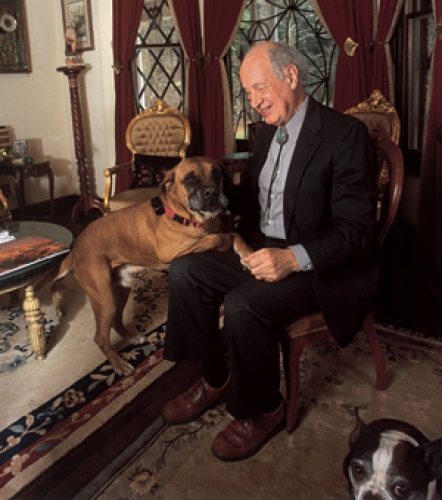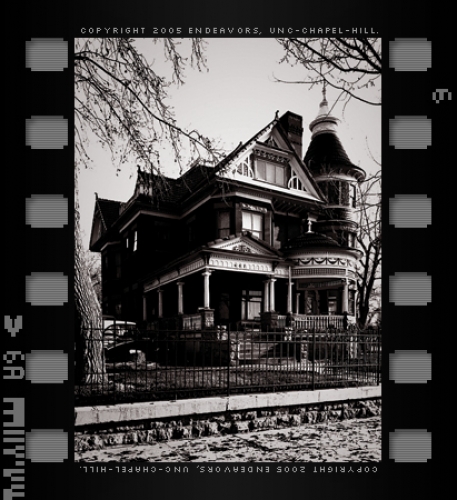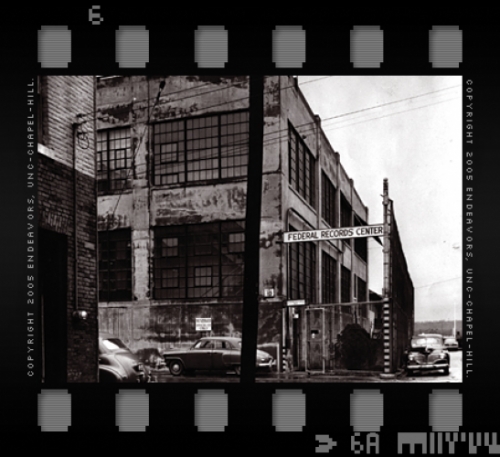At the end of a dirt driveway in rural Orange County stands a Victorian mansion with a spiraling turret, a wide veranda, stained glass windows, and gingerbread trim. If you know its owner — Gerhard Weinberg, emeritus professor of history — he might take you inside, among his musty old books, Egyptian accents, and European antiques. He might also tell you a story.
The story begins more than twelve years ago. He’s driving along in Rawlins, Wyoming, with his wife, Janet, when she orders him to stop the car. He waves her off. She demands, “Stop the car!” He pulls over, asks what the fuss is about. She tells him to back the car up. He does. “Here!” she yells. He stops. “There,” she says, as she points to the George Ferris Mansion, a Victorian bed and breakfast. “I want that house.”
The couple gets out of the car, enters the mansion, and asks questions of the owners. They learn the house was completed in 1903, it came from a mail-order catalogue, and it might be haunted by the ghost of a seven-year-old boy. They ask permission to take measurements. Less than a year later, in 1994, Weinberg builds a replica on a ten-acre tract of land.
“She fell in love with the house,” Gerhard Weinberg says today, as he climbs his slightly squeaky staircase. “I guess I did too.”
He enters his second-floor office, which occupies two adjoining bedrooms, and settles into a chair at his desk, next to a manual typewriter he uses for correspondence. He wears a bolo tie and a dark gray suit. Around him, pieces of petrified wood, fossil fish, and dinosaur bones peek from shelves of books and yellowing newspapers.
“I like to be surrounded by strange and interesting things,” he says, as he sweeps his hand around his office. “You just have to keep your eyes open to what’s out there. And you have to realize that there’s often a distinction between what you see and what’s really there.”
A golden discovery
Weinberg, who has no fewer than three books related to the Second World War coming out this year, has grounded his career as a historian in finding and seeing what others previously have not. Consider, for instance, his most famous find, which he unearthed almost half a century ago.
The year is 1958. Weinberg is an assistant professor at the University of Kentucky and spends his summers in an old torpedo factory in Alexandria, Virginia, reviewing declassified German records captured by the United States Army during the Second World War.
One day, as he sifts through the contents of one of the thousands of faded green boxes among the “miscellaneous materials,” Weinberg comes across a folder labeled “Partial Draft of Mein Kampf.” As a young scholar of twentieth-century German history and a native of the country, Weinberg has a deep familiarity with Mein Kampf, the only book then published and written by Adolf Hitler. He thumbs through the folder and the 324 yellowed pages of typescript tucked inside. Weinberg inspects the text — the XXXs crossed over letters, the misspellings, and the frequent spaces before periods to mark the end of sentences. Hitler, Weinberg recalls, dictated Mein Kampf as someone “banged away” on a typewriter.
So it looks like Mein Kampf. But now, Weinberg homes in on the opening lines of the manuscript: “In August 1925, while writing the second volume of Mein Kampf, I set out briefly due to constraints the basic idea of German Nationalist foreign policy.” Would Hitler really begin a draft of Mein Kampf this way? Weinberg’s mind dashes over sprinkles of evidence that a second book written by Hitler may exist: there was the 1949 book based on an interrogation of Hitler’s secretary, who stated that Hitler wrote a secret book about foreign policy. There was a recorded table-talk conversation in which, on February 17, 1942, Hitler refers to an “unpublished work.” And there was a letter written by an editor who claimed to have been shown, during the Second World War, a manuscript dictated by Hitler and stored in the Nazi publishing house’s safe.
“You have to understand,” Weinberg whispers today, leaning forward in his chair as if to share a secret, “that at the time I was working on a book about Hitler’s foreign policy. So if a second book of Hitler’s existed, I was very interested in it. And here,” he says, his voice rising, “I had it in my hands.” He settles back into his whisper, and adds, “I didn’t have to read far to realize that I had discovered a nugget.”
In 1961 this discovery is published, in Germany, as Hitler’s Second Book. An English-language publisher also agrees to publish a translation edited by Weinberg. But before this edition goes to press, a pirated copy with stolen footnotes and sloppy translations makes its way onto the market. Weinberg’s publisher backs out. Weinberg can’t sue the pirates because there’s no economic loss — he was not going to receive royalties.
So over the next forty years, Weinberg queries a dozen or so publishers about bringing Hitler’s Second Book into the English language and encounters rejection after rejection. Why? No one would tell him; he suspects that the pirated version scared them away. But the authenticity of Hitler’s Second Book has never been publicly doubted. It was found among documents known to be genuine. And recently, Daniel Levitt, who produced the documentary film Hitler’s Lost Plan — which first aired on the History Channel in December 2004 — arranged for forensic experts to examine the manuscript, now preserved in Germany. They concluded that the manuscript’s paper had been manufactured before 1954 because it contained no fluorescent chemicals, and they linked the text to a Remington typewriter made between 1920 and 1926. Mein Kampf was typed on a Remington made between 1920 and 1926.
“Here we had one of the central figures in the twentieth century who wrote all of two books, which were very likely typed on the same typewriter,” Weinberg says. “One of these books has long been available in a reliable English edition, and I was disappointed that no reputable publisher would publish his second book for forty years.
“I’m not saying this book is exciting reading,” he adds, “but it’s important reading.”
Breaking down illusions
Important, Weinberg says, because it changes what we know about Hitler.
Before 2003, when Enigma Books finally published Hitler’s Second Book, the popular perception of Hitler held that he was merely an anti-Semitic opportunist driven by ideology in a search for power.
But the uncensored manuscript Weinberg discovered reveals what Hitler really intended and why.
To get at those intentions, Weinberg started with the question of when the book was written. A letter written by Hitler’s secretary found in a German archive provides a clue. On June 26, 1928, Hitler’s secretary writes that “Herr Hitler will probably be away…in order to write his book.” A U.S. officer who confiscated the manuscript in 1945 noted on an attachment that the book was stored in the Nazi publishing house’s safe and had been written “more than fifteen years ago.” Based upon these pieces of information, Weinberg concludes that Hitler probably dictated his second book in the summer of 1928, after the Nazi party fared poorly in the parliamentary election that May.
Hitler believed a major reason for the Nazi’s dismal performance was because the party failed to clearly articulate its position on foreign policy, Weinberg says. So Hitler laid out this position in his second book: Germany needed to expand its “living space” by as much as five hundred thousand square kilometers to feed its people. To acquire this land, Germany must align with Italy, defeat France, broker a deal with Britain, and battle for bits of territory one at a time. But that wasn’t all. The final step, revealed in detail for the first time in Hitler’s Second Book, was to defeat the United States.
Why the United States? Beginning in 1924, U.S. policy had begun to favor immigrants from Germany and the Nordic countries. Hitler considered those immigrants who left Europe for the United States to be racially superior to those who remained. This, Hitler believed, helped explain why the United States had developed the unlimited resources — through technological and economic strength — to feed its people. Though Hitler envied the United States, it was also a dangerous opponent in his quest for world domination. “The only way to cope,” Weinberg says, “was through war.”
And Hitler, Weinberg says, followed this plan he set out in his second book — Germany aligned with Italy, defeated France, and battled Britain. And within an hour of the Japanese attack on Pearl Harbor, though he still waited for a deal with Britain, Hitler ordered war with the United States.
“Our current widespread view that our politicians don’t believe what they’re saying and have no intention to carry out what they promise to carry out is a very dangerous illusion,” Weinberg says in Hitler’s Lost Plan, the film produced by Levitt’s Veriscope Pictures. “Then it was, and it is today.”
Early memories
A.J.P. Taylor, a well-known historian of western European history who died in 1990 and was often considered more of a revisionist than Weinberg, once wrote in a review of Weinberg’s A World at Arms: A Global History of World War II that Weinberg “probably [has] unrivaled control of the archival material.” For A World at Arms alone, Weinberg spent fourteen years panning through millions of documents to research and write the 1,198-page narrative that won the Herbert Hoover Book Award in 1994 and has been described by others as a “masterpiece” and of “encyclopedic quality.”
But as he digs through archival material to inform his research, Weinberg’s studies parallel his darkest experiences.
Born on January 1, 1928, in Hanover, Germany, Weinberg’s childhood coincided with the rise of Hitler. Weinberg is a devout Jew. Stories from his childhood, he says, echo those of other Jews living under the Nazi state. Banned from public places. Beaten up in school. Watching synagogues burn. His father fired from a government post.
But this personal history doesn’t shape his research, Weinberg says.
He’ll remind you that his career as a historian began because he “simply wondered how the European countries found themselves in the mess of the summer of 1914,” when the First World War started. He’ll remind you that he wanted to be a scholar of nineteenth-century history, but wound up in the twentieth century because he held views about German Chancellor Otto von Bismarck that were so different than his graduate advisor that he “either had to change centuries or change schools.” He’ll also tell you the story of Horst.
During the last year of Weinberg’s life in Germany, in 1938, the Weinbergs housed a family of a mother, a father, and two sons. The youngest son, Horst, was about Weinberg’s age.
“Horst was, I would say, my only childhood friend in Germany,” he says.
Weinberg left Germany for England in December of 1938, after the “the night of broken glass,” when some thirty thousand Jews, including his father, were arrested. Britain changed its rules to allow people to stay in its borders while they waited for their visa quota-numbers to be called in order to immigrate to the United States. Weinberg and his siblings attended public boarding-schools there, while his parents remained in Germany until the spring of 1939.
When his parents arrived to England, his father was interned in a camp for enemy aliens, while his mother waited in London. In the summer of 1940, the Weinbergs’ visa number was called up, and the family reunited in September on a pier in Glasgow. They set sail to New York on the Cameronia, one of the last passenger ships to cross the Atlantic during the war. Ten days later, the Weinbergs arrived in New York Harbor.
“The bright display lights” of New York City is Weinberg’s first memory of the United States. And over the next fifty years, many memories come to follow — serving in Japan as a teacher and supply soldier for the U.S. Army in 1946; advising President Bill Clinton about the history of the Second World War before the fiftieth anniversary of the attack on Pearl Harbor; and winning the American Historical Association Award for Scholarly Distinction in 1999.
His friend has no such memories, Weinberg says. Horst and his parents stayed behind in Germany, where they were murdered.
“Horst would be about my age now,” Weinberg says. “He could have done something with his life. That people would take that boy…that’s something you don’t get over. I still don’t get it, frankly.
“The more you learn about Hitler and World War II — you can learn everything you want about it — but it still doesn’t clear any of it up very well,” he says. “No amount of study will erase the face of Horst sketched in my memory.”
So why devote more than fifty years of study to a topic that may stir such recollections?
As Weinberg sits in his Victorian house — his architectural ode to the past — he answers with a reference to a Gilbert and Sullivan operetta — The Mikado — in which Nanki-Poo falls in love with Yum-Yum.
“I can’t live without Yum-Yum,” Nanki-Poo says at one point to a friend, who responds, “But most people do.”
The same with history. “I can’t live and be happy and be me,” Weinberg says, “without being a historian.”
Cherry Crayton was formerly a staff writer for Endeavors.
Weinberg’s Visions of Victory: The Hopes of Eight World War II Leaders and the second edition of his A World at Arms: A Global History of World War II were published in March 2005 by Cambridge University Press; the second edition of his Hitler’s Foreign Policy: 1933-1939 will be published on August 25, 2005, by Enigma Books. Weinberg retired from teaching at UNC-Chapel Hill in 1999.






